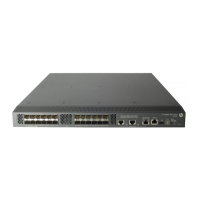45
Ste
Command
Remarks
7. User
interfac
e
configur
ation
Enable the terminal
service.
shell
Optional.
Enabled by default.
Enable the current user
interfaces to support
either Telnet, SSH, or
both of them.
protocol inbound
{ all | ssh | telnet }
Optional.
By default, both protocols are supported.
The configuration takes effect next time you
log in.
Define a shortcut key for
terminating tasks.
escape-key { default
| character }
Optional.
By default, press Ctrl+C to terminate a task.
Configure the type of
terminal display.
terminal type { ansi
| vt100 }
Optional.
By default, the terminal display type is
ANSI.
Set the maximum
number of lines on the
next screen.
screen-length
screen-length
Optional.
By default, the next screen displays 24
lines.
A value of 0 disables the function.
Set the size of history
command buffer.
history-command
max-size value
Optional.
By default, the buffer saves 10 history
commands.
Set the idle-timeout
timer.
idle-timeout minutes
[ seconds ]
Optional.
The default idle-timeout is 10 minutes for all
user interfaces.
The system automatically terminates the
user’s connection if no information
interaction occurs between the device and
the user in timeout time.
Setting idle-timeout to 0 disables the timer.
Specify a command to
be automatically
executed when a user
logs in to the current
user interface
auto-execute
command command
Optional
By default, command auto-execution is
disabled.
The system automatically executes the
specified command when a user logs in to
the user interface, and tears down the user
connection after the command is executed.
If the command triggers another task, the
system does not tear down the user
connection until the task is completed. A
Telnet command is usually specified to
enable the user to automatically Telnet to
the specified device.

